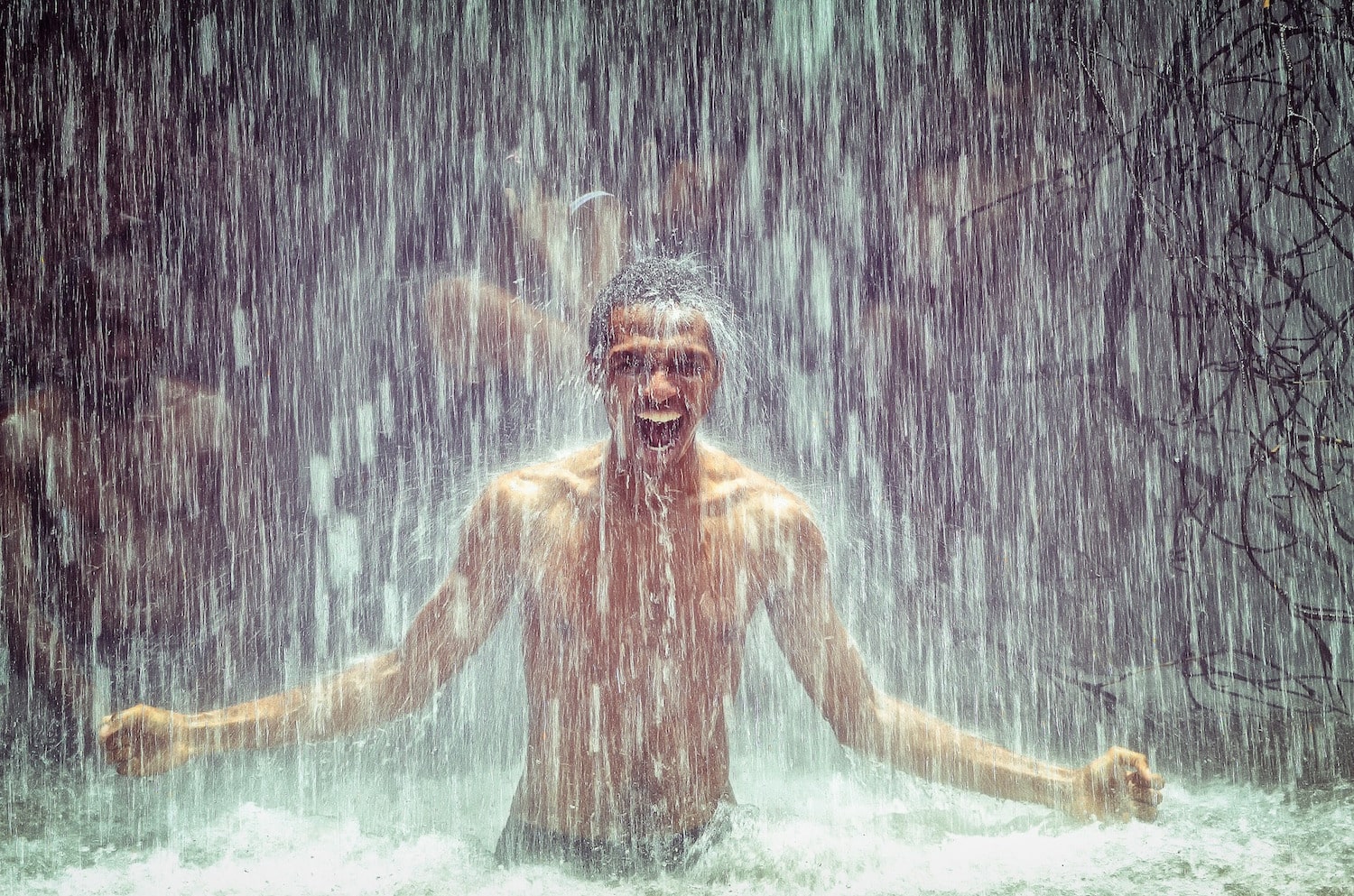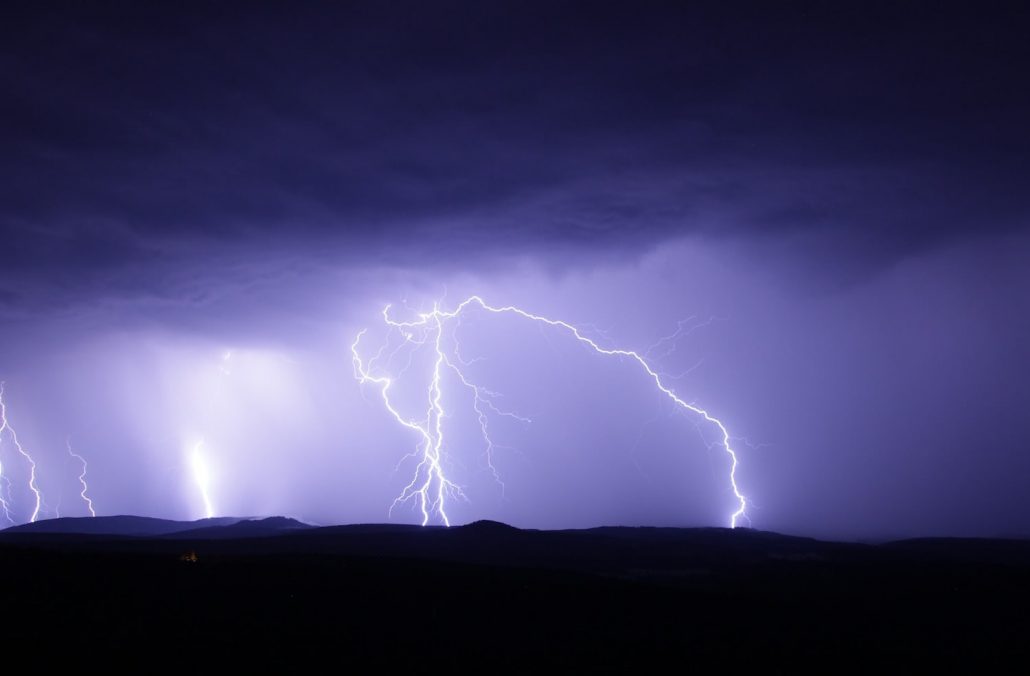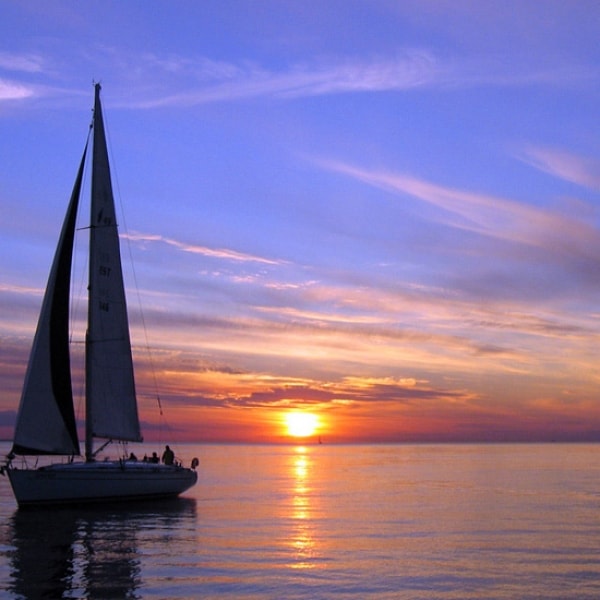So, you're visiting during the rainy season? Then hoo boy, do we have some Costa Rica travel tips up our sleeve.
Are you envisioning torrential downpours and epic thunderstorms, gray skies and a vacation spent huddling indoors, hiding from another miserable day?
Yeah, Costa Rica's rainy season isn't like that.
So, how much does it rain? Are we talking a few sprinkles or more like apocalyptic, monsoon-level downpours? Does everything shut down? Here's the short of it: Unless you're really, really unlucky – as in, once-in-several-years unlucky – it's not going to rain morning, noon, and night. It probably won't even rain noon and night. It may not even rain every day.
But we're getting ahead of ourselves. Hold on to your umbrella, because we're about to get real about Costa Rica's rainy season.

Costa Rica is located just 9º north of equator, which means we get 12+ hours of sunshine, year-round. (Fun fact: It also means we're very unlikely to ever experience a hurricane.) What's more, the sun rises and sets at about the same time every day, year round: 5:45 a.m. up, 5:45-6:30 p.m., down. Temperatures are also relatively stable, with only a few degrees of variation throughout the year. Sounds like steady, even-keeled weather, doesn't it? Enter: Rain. Because, from April through November, you have very, very good chances of seeing some. But, frequency and fury depend largely on where (and when) you're headed. But, Costa Rica is tiny!, you say. It's smaller than West Virginia, you protest! Why does it matter that we're in Tamarindo? Surely, Costa Rican weather is Costa Rican weather – right?! Wrong. So very, very wrong. Let's put it this way: You know how Costa Rica has a reputation for incredible biodiversity? Well, much of that biodiversity is due to a wide range of habitats, climates, and micro-climates. And that means, Costa Rican weather can vary greatly, region to region and even town to town. So, first things first: Our expertise relates to Tamarindo, an oceanfront town on Costa Rica's northwest coast. That said, what's the rainy season really like? Well, speaking for Tamarindo and, generally, fo the province of Guanacaste, rainy season is not that bad. Really, you could stop reading here and just skip straight to the packing list, if you don't want to know all the thunder-and-downpour details. But if you do, we have those, too:
As far as Costa Rican weather goes, we have what you might call transitional weather – think: sporadic rainy days but with furious thunderstorms, whensoever Mother Nature deems appropriate – then standard rainy season (daily rains common, but only for a couple of hours), and finally high rainy season, when the skies unleash all their stored-up tears, sometimes (but not usually) dumping us with a full day's worth of rain. (Hot Costa Rica travel tips: For most of the country, May-November marks the rainy, wet, or "green" season; but in the Caribbean and Arenal, the seasons are flipped. Sticking to generalities, Guanacaste province – including Tamarindo – is the driest in the country; this means we have drier rainy seasons, making Tamarindo a great choice for the best weather during May-November travel.) Ok, so do you want to know the breakdown, either so you can plan around it or brace for soggy impact? Here we go:
Okay, so – now you know. You know where you're headed, when you're headed there, and what to expect. You. Are. Ready. Except, are you? We always like to say: You haven't experienced rain until you've seen Costa Rica rain. Costa Rican rain likes to sneak up on you. It's the strangest (and most strangely wonderful) thing: You can be walking down the street, with the sky blue ahead of you, when a downpour literally sneaks up behind you. From nothing to EVERYTHING, you're immediately drenched. Luckily, it's tropical rain. It's warm. It smells great. And, sure, you can't see even a foot in front of you, but it's all good. You can pop into a store, huddle under a tree (if it's not thundering), or just walk it off. When's the last time you played in the rain? For us, it was today. That's the rainy season in Costa Rica. It re-makes a kid out of you. But, of course, there are practical considerations: Do you need a raincoat? How much sunblock should you bring? How often do you need to apply insect repellent in the rain? Do you need special shoes? And, even more importantly, what are you forgetting completely? Because you know there's something. Definitely something. You just have no idea what. We'll assume you've already perused our full Tamarindo packing list. So now, let's get super specific. What are the absolute packing musts for Costa Rican rainy season? Here's our don't-forget-it-or-you'll-regret-it packing list for Costa Rica's wet season:
What's Rainy Season Really Like?

Costa Rica is located just 9º north of equator, which means we get 12+ hours of sunshine, year-round. (Fun fact: It also means we're very unlikely to ever experience a hurricane.) What's more, the sun rises and sets at about the same time every day, year round: 5:45 a.m. up, 5:45-6:30 p.m., down. Temperatures are also relatively stable, with only a few degrees of variation throughout the year. Sounds like steady, even-keeled weather, doesn't it? Enter: Rain. Because, from April through November, you have very, very good chances of seeing some. But, frequency and fury depend largely on where (and when) you're headed. But, Costa Rica is tiny!, you say. It's smaller than West Virginia, you protest! Why does it matter that we're in Tamarindo? Surely, Costa Rican weather is Costa Rican weather – right?! Wrong. So very, very wrong. Let's put it this way: You know how Costa Rica has a reputation for incredible biodiversity? Well, much of that biodiversity is due to a wide range of habitats, climates, and micro-climates. And that means, Costa Rican weather can vary greatly, region to region and even town to town. So, first things first: Our expertise relates to Tamarindo, an oceanfront town on Costa Rica's northwest coast. That said, what's the rainy season really like? Well, speaking for Tamarindo and, generally, fo the province of Guanacaste, rainy season is not that bad. Really, you could stop reading here and just skip straight to the packing list, if you don't want to know all the thunder-and-downpour details. But if you do, we have those, too:
Rainy Season: Month-by-Month

As far as Costa Rican weather goes, we have what you might call transitional weather – think: sporadic rainy days but with furious thunderstorms, whensoever Mother Nature deems appropriate – then standard rainy season (daily rains common, but only for a couple of hours), and finally high rainy season, when the skies unleash all their stored-up tears, sometimes (but not usually) dumping us with a full day's worth of rain. (Hot Costa Rica travel tips: For most of the country, May-November marks the rainy, wet, or "green" season; but in the Caribbean and Arenal, the seasons are flipped. Sticking to generalities, Guanacaste province – including Tamarindo – is the driest in the country; this means we have drier rainy seasons, making Tamarindo a great choice for the best weather during May-November travel.) Ok, so do you want to know the breakdown, either so you can plan around it or brace for soggy impact? Here we go:
Rainy Season Weather in: May
May is a transitional month throughout much of Costa Rica, ushering in the rainy season with occasional thunderstorms and rain showers. So, how does Costa Rica define "occasional"? Depending on your location and luck, you could see anything from no rain during a weeklong stay (more likely in drier Guanacaste and Tamarindo), to everyday rains. (Honestly, neither is common. Assume some rain.) Thunderstorms, when they occur, are impressive. Exceptions to the rule: Arenal welcomes its dry season in May. Monteverde usually wrings an extra month out of its dry season, so you may get lucky there, as well.Rainy Season Weather in: June
By June, Costa Rica is well into the rainy season: daily rain is common, if not guaranteed, though showers often last just an hour or two. Exceptions to the rule: Arenal is now in high dry season, although as one of the rainier areas of Costa Rica, you may still get caught in the occasional shower.Rainy Season Weather in: July
Rainy season continues with daily showers, usually in the afternoon. Thunderstorms are still common but are not as vehement as in May and June. Exceptions to the rule: Arenal is still in high dry season, although as one of the rainier areas of Costa Rica, you may still get caught in the occasional shower.Rainy Season Weather in: August
Rainy season continues with daily showers, usually in the afternoon. Thunderstorms are still common but are not as intense as in May and June. Exceptions to the rule: Arenal is still in high dry season, although as one of the rainier areas of Costa Rica, you may still get caught in the occasional shower.Rainy Season Weather in: September
September is the second-rainiest month of the year in most of Costa Rica, especially during La Niña years. (2019 is an El Niño year; 2020 will be a La Niña year; 2021 will revert to El Niño, and etc. etc.) All-day rains are not common but not unheard of, either; typically, you'll have sunny mornings and all-afternoon rains. Guanacaste and Tamarindo have slightly better (= drier) weather. Exceptions to the rule: The Caribbean coast hits its driest season in September, and Arenal continues to bask in the sun.Rainy Season Weather in: October
Hands down, October is the rainiest month of the year. All-day rains are possible but typically, you'll have sunny mornings and all-afternoon rains. Guanacaste and Tamarindo have slightly better (= drier) weather, but don't bank on full days of sun. Exceptions to the rule: The Caribbean coast and Arenal both enjoy a continued run of dry and sunny weather.Rainy Season Weather in: November
November is a transitional month for all weather in Costa Rica: most of the country witnesses a transition away from everyday rain showers, while the Caribbean and Arenal begin seeing more rain and less sun. Exceptions to the rule: None. It's pretty windy, however, in Monteverde!Must-Have Costa Rica Travel Tips: Packing for Rainy Season

Okay, so – now you know. You know where you're headed, when you're headed there, and what to expect. You. Are. Ready. Except, are you? We always like to say: You haven't experienced rain until you've seen Costa Rica rain. Costa Rican rain likes to sneak up on you. It's the strangest (and most strangely wonderful) thing: You can be walking down the street, with the sky blue ahead of you, when a downpour literally sneaks up behind you. From nothing to EVERYTHING, you're immediately drenched. Luckily, it's tropical rain. It's warm. It smells great. And, sure, you can't see even a foot in front of you, but it's all good. You can pop into a store, huddle under a tree (if it's not thundering), or just walk it off. When's the last time you played in the rain? For us, it was today. That's the rainy season in Costa Rica. It re-makes a kid out of you. But, of course, there are practical considerations: Do you need a raincoat? How much sunblock should you bring? How often do you need to apply insect repellent in the rain? Do you need special shoes? And, even more importantly, what are you forgetting completely? Because you know there's something. Definitely something. You just have no idea what. We'll assume you've already perused our full Tamarindo packing list. So now, let's get super specific. What are the absolute packing musts for Costa Rican rainy season? Here's our don't-forget-it-or-you'll-regret-it packing list for Costa Rica's wet season:
Clothing
We're going to assume you have the basics down – bathing suit, shorts, shirt, sandals, underwear, etc. – and skip straight to the rainy-season clothes you may not know you need (but definitely don't want to leave at home):- Waterproof Boots: A lot of people will say you can hike in sandals. We say, there are venomous snakes in Costa Rica and it's always advisable to hike the dry forest, wet forest, mangrove forest, and backcountry – basically, anywhere that's not paved or asphalted – in a comfortable, close-toed boot. If you don't plan to do much walking, sneakers will suffice. Either way, make 'em water-resistant or waterproof.
- Quick-dry Socks: Whether you're splashing through puddles, hiking the rainforest or just sweating, a few pairs of moisture-wicking, quick-dry socks are all you'll need. Just wash in the sink and hang dry for the next hike!
- Rain Jacket/Parka: This one's personal preference, but here's the litmus test: Are you adverse to getting rained on? If you're the type who loves to walk in the rain, then you probably won't need a full-fledged rain jacket. But, if you like to stay dry, you'll want to pack a lightweight (read: not too hot) rain jackets.
- Poncho: If you're not the raincoat type – and, yes, even if you like walking in the rain – do yourself a favor and pack some super compact, unisex ponchos for adults and kids. (You can also pick some up locally, likely with a markup.)
- Water Sandals: Waterproof sandals – something comfortable and secure on your feet – are a great choice for long walks along rugged coast, rocky beaches, and in cool rivers.
- Sun Hat: Think you don't need a sun hat in rainy season? Well, we promise – you're going to see sun! Pack a hat with built-in SPF and, if you can, pull double-duty with a waterproof sun-and-rain hat.
Gear + Goodies
Even if you don't plan on every outdoor activity Costa Rica has to offer, you'll still want to pack some outdoor gear. From Tamarindo surfing to hiking Rincón de la Vieja's active volcanic slopes, chances are good that you'll need a few of these extras to keep you safe and dry:- Shockproof, Waterproof Camera: Costa Rica is an adventure, so you're going to need a camera that's adventurous, too. One of our top Costa Rica travel tips? Pack a waterproof, drop-proof and tropics-proof camera.
- Floating Camera Strap: A waterproof camera is no good if it sinks.
- Waterproof Electronics Bag: Whether you're kayaking, waterfall rappelling, surfing, sailing, or just braving the October weather, you'll want a secure, waterproof bag to stash your pricey electronics.
- Dry Sack: If you plan to get adventurous during rainy season, you should really bring a waterproof dry bag, which you can pack full of the day's supplies, including your electronics, your wallet, and a change of clothes.
- Travel Surge Protector: The threat of lightening is real, y'all. Don't leave your electronics to chance.
- Travel Hairdryer: If dry hair is an absolute must, and if you're not sure your Tamarindo vacation rental supplies one (ask us!), then bring along your own. Otherwise, you may be rocking the damp looking during your vacay.
Health & Safety
One of our top Costa Rica travel tips? Waterproof your health during the rainy season. Nope, not kidding.- Waterproof Sunscreen: The sun is strong at 9º north of the equator. Yes, even when it's overcast. Be sure to pack some high-factor water-resistant sunblock, plus facial sunblock and wet-apply sunblock. And then, reapply (seriously) every 90 minutes.
- Water-resistant Insect Repellent: Protect yourself with a strong defense! We recommend a natural insect repellent for everyday use and can't stress strongly enough that you'll want to get one that's water-resistant. (Lotions can be good for that.) Look into repellent bracelets and stickers, which are not only waterproof but often natural, too!
- Flashlight: Due to storms and especially thunderstorms, the power goes out often during the rainy season. (Although usually, it's back within minutes or an hour.)
Books & Field Guides
- Waterproof Travel Map of Costa Rica: This rugged travel map will see you through thick and thin, even if a downpour catches up to you in the rainforest!
- Pocket Naturalist Guides: Speaking of waterproof, we love these small, folding, and waterproof guides to Costa Rican nature.


